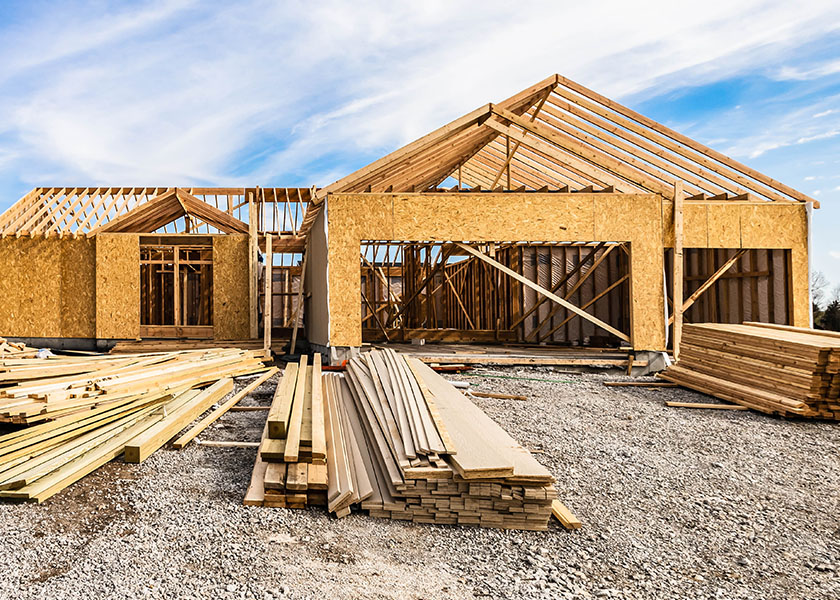It was bound to happen. Stocks finally lost ground last week, as the S&P 500 ended a five-week win streak and the NASDAQ fell for the first time in eight weeks. It is important to note that late June historically isn’t strong for stocks, and this weakness is not overly concerning after the market’s recent run.
- Stocks finally fell last week, ending the S&P 500’s five-week win streak.
- Overall, the underpinnings of this new bull market are alive and well, and higher prices will likely continue for the second half of 2023.
- Housing is making a sharp turnaround, and that’s very positive for the economy.
- Single-family starts and permits jumped in May, as homebuilders became increasingly confident about demand.
- Multi-family housing data indicate many more units will come online, which will further ease inflation pressure.
The S&P 500 is still up more than 13% for the year, which many investors would have gladly taken six months ago. At that time, many were embracing the 5% sure bet from short-term bonds and avoiding stocks. After one of the worst years ever for stocks, this made sense. But history is full of examples of stocks roaring back from steep declines, and we didn’t expect 2023 to be any different. The question now is, can this rally continue? We think it can.
The economy continues to surprise to the upside, with housing a potential wildcard that few are discussing. More on that below. So, what does a good first half of the year mean for the remainder? It’s usually good news. We found the S&P’s median return for the final six months of the year is 5.0%. When stocks have risen 10-15% by the end of June, the final six months have been higher 12 out of 12 times and up close to 11%. In other words, stocks are well positioned for continued gains.
Good News on Housing Is a Big Deal for the Economy
Housing, or specifically residential investment, has been a drag on the economy for eight straight quarters. No surprise why: The Federal Reserve has pursued its most aggressive policy tightening cycle in 40-plus years in an effort to curb inflation. That sent mortgage rates from 3% to 7% in less than a year, freezing the housing market. Affordability collapsed due to higher rates and elevated home prices. Amid decreasing demand, builders reduced their involvement in new construction projects.
Historically, declining housing activity has foreshadowed recessions. Between 1980 and 2010, there were five recessions, and each was preceded by a huge decline in single-family housing starts. Housing starts measure the start of construction on a new residential unit. Starts are followed by sales of new homes as well as spending on appliances, furniture, and other home goods. They tell us a lot about builders’ sentiment for investing in new projects and how consumers view their personal financial situations, since buying a house is a large investment.
But this is also important: Housing has historically bottomed prior to the end of a recession and has typically led the economy out of one. Its rebound has generally coincided with the Fed reducing interest rates in response to a slowing economy.
In the current cycle, housing activity collapsed last year amid interest rate hikes. That increased the odds of a recession, but the economy persevered. Now we’re on the other side of the housing crash.
Homebuilder sentiment, perhaps the best leading indicator for housing activity, has been surging since the end of last year. Builders are clearly feeling much better about future demand, and the aggregate housing data confirm this.
May housing starts and building permits were also strong. The number of permits reflects new housing units and is a leading indicator of future supply.
Single-family starts surged 19% in May. Meanwhile, economists expected a small fall in starts, once again highlighting the disconnect between what’s happening in the economy and expectations. Over the past six months, single-family starts have risen 24%.
Permits rose 5% in May and are up 13% since last November. Builders wouldn’t be attempting to authorize new construction if they were pessimistic about the housing market.
These numbers are typical of an economy emerging from a recession. They indicate a couple of things:
- The economy is not in a recession or very close to one (within 1-2 months).
- It doesn’t appear we are late in the economic cycle nor on the precipice of a recession (within the next 4-6 months).
If anything, the current dynamics are akin to what is typically seen early in an economic expansion, which goes against forecasts that predict an imminent recession. This is good news for the economy, since residential investment may move from being a drag to a positive contributor.
Impressive Housing Data Also Bode Well for Inflation
The data above refer to the single-family housing segment. But there are also positive dynamics in the multi-family segment.
Multi-family starts surged 28% in May and are now up 40% from a year ago.
Note: This segment is always very volatile, and we can assume there’ll be downward revisions. But that is still a significant jump and puts the current level of multi-family starts at the highest point since December 1985.
What’s interesting within the multi-family segment is starts are outpacing completions by a wide margin despite a 23% jump in completions in May.
The data tell us two things:
- Supply-chain issues are easing, which is leading to more completions. This was a major problem in 2022.
- Builders are positive about future demand for condos and rentals.
In short, there’s a lot more supply coming as completions rise.
The supply picture becomes even starker when we consider the number of multi-family units under construction. These rose 1.6% in May and are up 17% over the past year. In fact, the total number of multi-family units under construction matches the record set in May 1973.
The main reason for so many units remaining “under construction” is that supply-chain issues created construction bottlenecks. But that’s easing now, and completions are rising. That means a surge of rental units is entering the market, and more is on the way.
More Rental Units = Lower Inflation Pressure
Core inflation, which excludes food and energy, appears to have made no progress at all in recent months. Over the past three months, it has run at a 5% annualized pace. The good news is it’s down from a peak of more than 7% and it’s not accelerating. However, it’s been hovering in the 4-5% range since last November.
The problem is housing, or shelter, inflation. Official shelter inflation is measured via rents, but the challenge is it lags actual market rents by 12-18 months. Private rents have decelerated sharply, slowing from a peak pace of 18% year-over-year to 1%. It’s taken a while, but the official data are finally turning around, slowing from an annualized pace of 8-11% a few months ago to 5-6% in May. That’s still high, which is why core inflation remains elevated. But expect to see core inflation move lower over the next 6-8 months as official rental inflation decelerates even further.
The multi-family housing data indicate further downward pressure on rent inflation well into 2024, as even more units come online. That will alleviate significant pressure on the Federal Reserve, potentially leading to a sequence of interest rate cuts in 2024.
Stack the housing turnaround, lower core inflation, and a potential end to the rate hike cycle on top of the following:
- continued strength in consumption;
- growing incomes as energy and food prices fall;
- easing supply chain bottlenecks; and
- pickup in manufacturing, especially for the auto sector.
You can see why we’re optimistic about the economy.
This newsletter was written and produced by CWM, LLC. Content in this material is for general information only and not intended to provide specific advice or recommendations for any individual. All performance referenced is historical and is no guarantee of future results. All indices are unmanaged and may not be invested into directly. The views stated in this letter are not necessarily the opinion of any other named entity and should not be construed directly or indirectly as an offer to buy or sell any securities mentioned herein. Due to volatility within the markets mentioned, opinions are subject to change without notice. Information is based on sources believed to be reliable; however, their accuracy or completeness cannot be guaranteed. Past performance does not guarantee future results.
S&P 500 – A capitalization-weighted index of 500 stocks designed to measure performance of the broad domestic economy through changes in the aggregate market value of 500 stocks representing all major industries.
The NASDAQ 100 Index is a stock index of the 100 largest companies by market capitalization traded on NASDAQ Stock Market. The NASDAQ 100 Index includes publicly-traded companies from most sectors in the global economy, the major exception being financial services.
A diversified portfolio does not assure a profit or protect against loss in a declining market.
Compliance Case # 01813768






